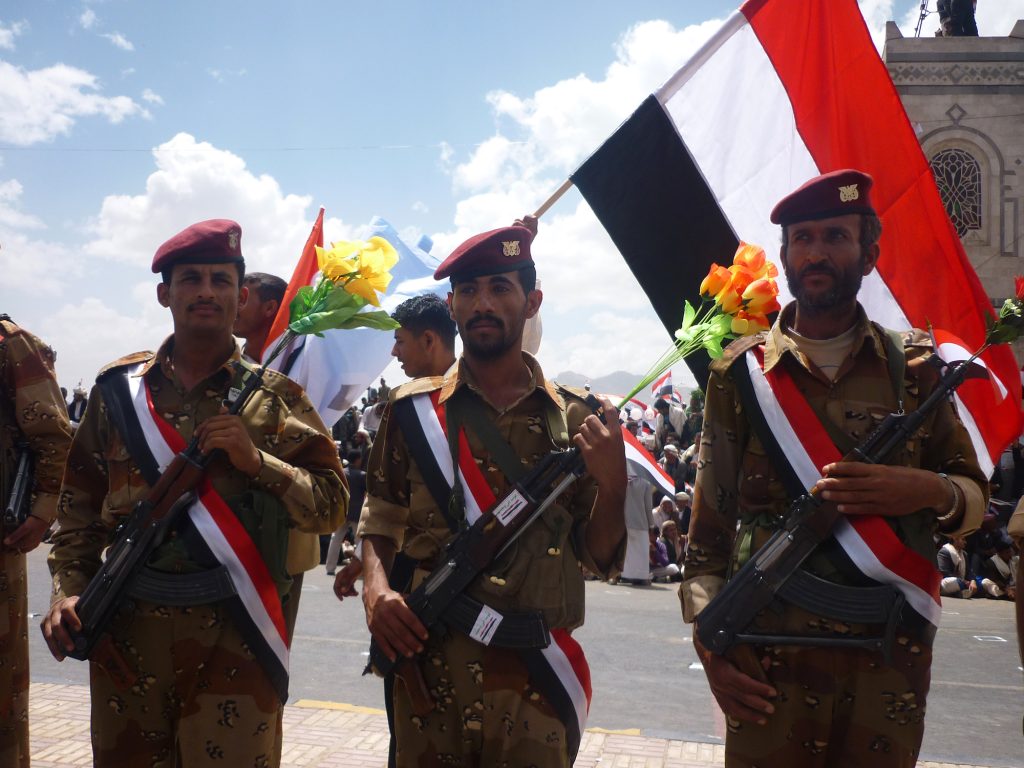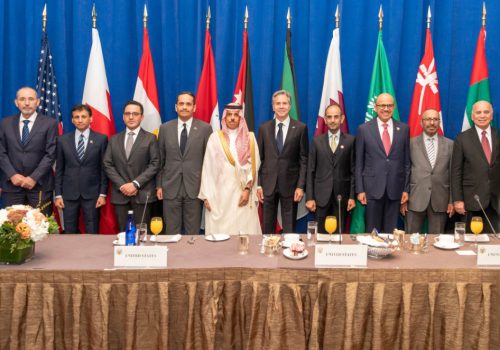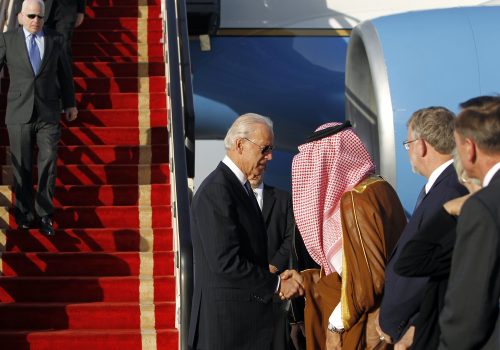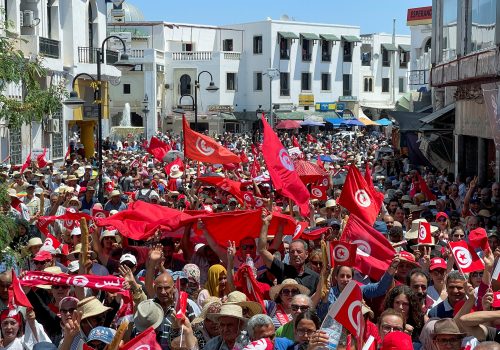The fundamental challenge in achieving a sustainable resolution of the current conflict in Yemen is that the issues at stake are fundamental to Yemen’s identity and history. In fact, it reflects the core issues that have undermined peace and security in the country since at least the 1960s when a successful revolution in North Yemen ended the millennium-old imamate and a quasi-Marxist revolt in the south ended Britain’s protectorate. Over the course of the six decades since, no effort—domestic, regional, or international—to address Yemen’s persistent issues of political disenfranchisement, economic marginalization, and social inequity has succeeded.
Notably, the Yemenis themselves repeatedly negotiated agreements aimed at resolving their internal conflicts. When over twenty years of internal upheavals, coups, assassinations, and cross-border conflicts brought about a hastily negotiated agreement to unite the north and the south in 1990, unity lasted a scant four years before civil war, driven by southern discontent, threatened to upend it. Negotiators from the two sides came together to agree on a Document of Pledge and Accord to address southern grievances and agree on steps to end sectional inequality and decentralize governance. The effort failed to stop the move to disunion and conflict ensued. In the early 2000s, six rounds of fighting between the government of Ali Abdullah Saleh and the Houthis—driven again by Houthi claims of economic, social, and sectarian inequality—produced temporary truces, often with the help of Qatari and international mediators, but no lasting settlement of their differences.
The stage was set by 2011 for a popular movement to end Saleh’s thirty-year tenure as Yemen’s president. Beyond domestic grievances exacerbated by Saleh’s increasingly sclerotic and authoritarian rule, young Yemenis were encouraged by the Arab Spring uprisings in Tunisia and Egypt to come into the streets. Although driven especially by Yemeni urban youth, the Arab Spring uprising reflected a broader coalition of disaffected Yemenis, including women, civil society, southerners, and the Houthis. These Yemenis were united by not only opposition to the Saleh government itself but also a sense that the political crisis could pave the way for a new effort to address Yemen’s long-standing structural problems. Thus, Yemeni negotiators, with strong support from the Gulf Cooperation Council (GCC), the international Friends of Yemen, and the United Nations (UN), formulated a transition blueprint that both allowed for the organization of a transitional government under the leadership of Abd Rabbo Mansour Hadi and called for a broad-based gathering, the National Dialogue Conference (NDC), with a mandate to address deep-seated political, economic, and social challenges facing the country.
Over the course of a year, from 2013 to 2014, over five hundred Yemenis representing a broad cross-section of the population met to consider the full range of issues of governance, economy, and society confronting the country. At the end of their deliberations, the delegates adopted by consensus over 1,600 recommendations reflecting their discussions. (Although having participated fully in the work of the NDC, the Houthis declined at the last minute to endorse the NDC conclusions, allegedly in protest of the assassination of Ahmed Sharaf al-Din, a Houthi representative to the talks. Their refusal to implement agreements or fulfill commitments they had negotiated has been a pattern of behavior that has carried over to the present day.) But echoing past experience, security conditions in the country deteriorated in the ensuing months until the Houthis, in a conspiracy with deposed former President Saleh, swept into Sana’a and upended the political transition.
Desperate to preserve the political transition launched in 2011, UN Special Envoy Jamal Benomar mediated a new agreement between the Houthis and the political parties, the Peace and National Partnership Agreement, that yielded to Houthi demands and allowed for sweeping changes in the GCC transition agreement. But the Houthis immediately reneged on the agreement they had negotiated and set off the chain of events that led to the civil conflict still ongoing eight years later.
Since the onset of the civil conflict, there have been numerous domestic initiatives to negotiate local cease-fires, prisoner exchanges, and other measures to try to alleviate the worst impacts of the conflict on the Yemeni population. Many of these efforts were led by women’s groups, tribes, and other local actors. But the larger effort to find a durable end to the conflict and establish a path to an overarching political resolution has been left largely in the hands of the United Nations and other international actors. In the summer of 2016, there was some optimism that a UN-led mediation in Kuwait would produce a comprehensive agreement to end the fighting and restore a political transition. But the mediation collapsed in the end as the Houthis walked away from the negotiating table.
Since that effort, UN engagement in Stockholm in 2018 and more recently in the series of two-month cease-fire agreements in effect since April have focused on more modest confidence building measures (CBMs), e.g., forestalling a coalition assault on Hodeidah; reopening the Sana’a airport for limited service; allowing fuel shipments to enter the country through the Houthi-controlled port at Hodeidah; and lifting the siege of Yemen’s third-largest city, Taiz. Nevertheless, despite the overall positive result of the cease-fire agreements, the Houthis’ failure to implement their obligations, especially reopening the roads around Taiz to allow for free movement of the population, has reinforced concerns about Houthi intentions to resume their military operations. The Houthi refusal to extend the ceasefire for a fourth time in early October has added to concerns that they may be preparing for a new military offensive as international efforts continue to broker a new agreement.
In fact, it is clear that no mediation effort to go beyond CBMs, whether domestic, regional, or international, can succeed in the absence of any indication that the Houthis have concluded that their military adventure has reached an end. Recent comments by UN Special Envoy Hans Grundberg expressing concern about the potential that Yemen could see a return to open conflict reflect the international community’s frustration over Houthi negotiating intransigence. Thus, the principal challenge for potential negotiators is to find the means to apply pressure on the Houthis. However, the Houthis’ ideological and millenarian vision that they are the sole and rightful rulers of Yemen has made it difficult to identify pressure points short of a military defeat. Moreover, the Houthis themselves are internally divided, as some remain committed to fighting until they achieve a complete military conquest while others would be willing to accept participation in a political process. Economic incentives among those who have grown wealthy in the war economy are also a deterrent factor in pushing the Houthis toward negotiation.
The experience of the National Dialogue Conference has also made clear that the engagement of a broad cross-section of the Yemeni population, to include women, youth, civil society, and other previously excluded populations, is ultimately vital if Yemen is to overcome its structural inequities. Indeed, the NDC can be considered a success, despite the subsequent descent into civil war, as it brought new voices and new perspectives to the table and provided them with a platform to debate Yemen’s challenges and opportunities. As the UN considers new possibilities for expanding the negotiating process, it should first consider completing the NDC process interrupted by the conflict and permit the Yemeni population to express their views on the hundreds of NDC recommendations issued in 2014. While many of those recommendations are likely no longer valid given the changes that have occurred in the last eight years, there might be much that is still positive and that should be retained.
As a key international partner for Yemen, the United States must continue to play a leading role in the peace process. In fact, US contributions to the effort to forge a peaceful outcome have varied over the time period. During the Trump administration’s four-year term, the United States maintained its support in principle for a peaceful resolution of the Yemen conflict but did little to sustain Secretary of State John Kerry’s hands-on engagement in the negotiating process. Instead, President Donald Trump generally supported the Saudi-led coalition policies on the Yemen conflict. That changed with the advent of the Biden administration. President Joe Biden took two steps at the beginning of his term that he hoped would advance a diplomatic breakthrough in Yemen: He appointed a special envoy for the conflict and announced that the United States would throw its weight behind the UN-led diplomatic effort; and he launched a process aimed at restoring the Joint Comprehensive Plan of Action with Iran, which he hoped would encourage the Iranians to play a constructive role in ending the Yemen conflict.
Neither step has produced the desired result. The negotiations on the Iranian nuclear file remain stalemated and there is no evidence that Iran has been willing to use its influence with the Houthis to encourage their participation in negotiations to end the conflict. In fact, Iran increased its illicit weapons supply to the Houthis over this time period to enable more, and more lethal, attacks in Yemen and on Yemen’s neighbors and appears to be expanding its use of the Houthis as a core element of its “arc of resistance.” Similarly, the Houthis showed signs of misreading Biden’s intentions, believing that his actions, especially pressuring Saudi Arabia to end its military operations in Yemen, would open the door for their military victory. Rather than agreeing to return to negotiations, the Houthis increased their military operations until early 2022 when setbacks in Shabwa and Marib governorates pushed them into accepting the string of two-month cease-fires.
Yemen cannot begin the process of recovery and reconstruction in the absence of a clear path toward ending the conflict and agreeing on a political horizon. Thus, the short-term objective for the international community must remain achieving a binary agreement between the Houthis and the government. Yet, that essential predicate is unattainable unless and until the Houthis accept the need to be a part of that process. Until now, the Houthis have resisted political negotiations and have not accepted the need to abandon their maximalist demands. Neither the UN, nor the United States, nor any other international actor has yet identified the means to impel a change in the Houthi position. Thus, while the UN and its partners must continue efforts to engage the Houthis and sustain the measures that have reduced, but not eliminated, the harm being done to the Yemeni population, the prospects for achieving a comprehensive end to the conflict remain discouraging.
In the interim, it may be possible to pursue a “containment” strategy that seeks to identify mitigation schemes to reduce the economic and social costs of the conflict on Yemeni civilians, especially in areas away from the front lines, while the fighting continues. Cooperative efforts to restore energy exports, for example, can produce much needed foreign exchange to be used for paying civil service salaries and making welfare payments. In exploring these options, care will need to be taken to ensure that the temporary containment measures do not become de facto permanent settlements.
Ambassador Gerald Feierstein is a distinguished senior fellow on U.S. diplomacy at the Middle East Institute, and director of its Arabian Peninsula Affairs program.
In partnership with

Further reading
Fri, Oct 7, 2022
The MENA region’s uneasy path towards reforms
Report By
Decade-old geopolitical transformations have impacted the Middle East and North Africa (MENA) states’ efforts to implement socioeconomic reforms. More recently, the Ukraine war’s reverberations are also likely to affect the MENA countries’ paths towards such reforms.
Tue, Jul 12, 2022
Evolving MENA power balances: What is next for US engagement in the region?
In-Depth Research & Reports By
US President Joseph R. Biden Jr.’s upcoming visit to the Middle East provides an opportunity to assess what role the United States will play in the Middle East and North Africa in the future. With the war in Ukraine further diverting US attention from the region, the big question is whether the region is entering a ‘post-US’ era.
Mon, Aug 29, 2022
North Africa’s transatlantic relations amid change and continuity
Report By
The purpose of this report is to identify a potential role for Italy and its diplomacy to play in North Africa, in full agreement and collaboration with the United States and the other main European actors.
Image: Yemeni soldiers from the 1st Armoured Division on 60th Street in Sana'a, 22 May 2011. Photo: Ibrahem Qasim



